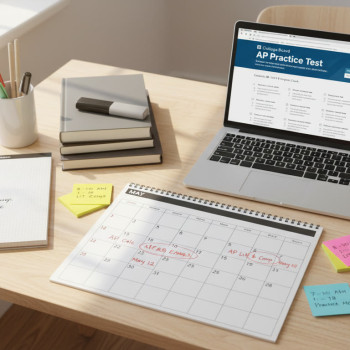Why “When to Skip” Matters More Than You Think
There’s a subtle art to taking AP multiple-choice sections: it’s not only about what you know, but also about how you use time and mental energy. Skipping questions strategically — and returning with a smart pass-order — can turn a panicked hour into a calm, controlled performance. In this post we’ll walk through a practical framework to decide when to skip, how to order your passes, and how to practice this plan until it becomes second nature.
The problem most students face
When the clock feels like it’s speeding up, many students either get stuck on a tough question or rush every remaining item. Stuck questions eat up time and confidence. Rushing compromises accuracy. The best path is a clear, repeatable decision rule: answer what you can quickly and confidently, skip what you can’t, and come back with a prioritized pass-order.

Core Principles of an Optimal Pass-Order
Before diving into practical steps, anchor yourself in four core principles that guide every good pass-order strategy:
- No penalty for guessing: On most AP multiple-choice sections, you don’t lose points for incorrect answers. That shifts the focus from avoidance to efficient time allocation.
- First-pass triage: Quickly triage questions into categories: easy (answer now), medium (mark and return), and hard (skip and return later).
- Time-blocked return: Reserve structured time blocks for second and third passes rather than leaving everything to the last five minutes.
- Confidence-to-effort ratio: Prioritize returns by expected points gained per minute spent.
Why confidence-to-effort ratio? A quick intuition
If a question looks like it will take 90 seconds and you’re 50% sure of the correct answer, that’s lower expected yield than a 30-second question where you’re 80% sure. Good pass-order maximizes expected score per minute, not raw per-question time.
Step-by-Step: The Three-Pass System
This system is easy to practice and reliable under stress. Think of each pass as a clear job with its own rules. Below, we’ll present a sample timing plan for different AP formats (paper and digital) and concrete decision rules for each pass.
Pass One — The Quick Harvest (Triage)
Goal: Collect all the low-hanging fruit and mark items for later. Speed and accuracy matter: answer anything you can with high confidence in under your per-question target time.
- Time: Use about 40–50% of the total MCQ time on this pass.
- Rule: If you can answer it in less than your per-question target time and feel 80%+ confident, bubble it in and move on.
- Marking: Put a simple mark (circle, dot, or digital flag) on medium-difficulty questions. Use a different mark for ones that require calculations or scratch work.
- Don’t: Don’t stall. If you’re wavering for longer than the target, mark and move to the next question.
Pass Two — The Prioritized Return
Goal: Attack medium-difficulty questions, grouped by expected time to solve and confidence. This is where you get the most additional points per minute.
- Time: Allocate about 30–40% of MCQ time to this pass.
- Ordering: Sort marked questions into three buckets: quick (under 60s), moderate (1–3 minutes), and slow (3+ minutes). Start with quick bucket.
- Technique: For calculation questions, set up the math cleanly before answer choices distract you. For content questions, eliminate obviously wrong choices first — often 1 or 2 answers can be discarded immediately.
- Use scratch: If the exam is digital and you have a built-in whiteboard or scratch paper, jot fast diagrams or formulas to keep working memory free.
Pass Three — The High-Risk, High-Reward Round
Goal: Use remaining time to attempt difficult questions, educated guesses, and fill in anything unanswered. This pass is also for sanity checks and double-checking computations on answers you’re already less certain about.
- Time: Leftover time — ideally 10–20% of MCQ time, no less than 5–10 minutes if possible.
- Strategy: For questions you don’t know, use elimination to raise the odds before guessing. If no elimination is possible, make a strategic guess and move on.
- Final sweep: If time permits, quickly scan all unanswered problems to ensure every bubble is filled. Remember: unanswered is never better than guessed when there is no penalty for wrong answers.
Sample Timing Plans (Apply to Your Exam)
Different AP exams have different numbers of MCQs and time allocations. The table below shows example per-question target times and how to split your three passes for three common formats. Use this as a template and adapt to the actual exam you’re taking.
| Exam Format | Total MCQs | Total MCQ Time | Per-Question Target | Pass 1 / Pass 2 / Pass 3 |
|---|---|---|---|---|
| Standard 60-question | 60 | 60 minutes | 1 minute | 30 min / 20 min / 10 min |
| 40-question (e.g., some recent digital formats) | 40 | 40–50 minutes | 1–1.25 minutes | 20–25 min / 12–18 min / 5–7 min |
| 80-question high-volume | 80 | 80–90 minutes | 1–1.125 minutes | 40 min / 30 min / 10–20 min |
How to set your per-question target
Divide the total MCQ time by the number of questions and then subtract a small margin for reading instructions and transitions. For digital exams, add a buffer for the navigation between questions and any technology quirks.
Decision Rules — Concrete, Easy-to-Remember Heuristics
Decision rules turn strategy into action under pressure. Practice these until they’re automatic:
- 30/60/120 rule: If you can answer within 30 seconds, do so immediately. If it will plausibly take under 60 seconds with a quick calculation or recall, mark and schedule for Pass Two. If it looks like a 2-minute-plus problem or requires a long proof or multi-step algebra, skip to Pass Three unless it’s on-topic and you’re confident.
- Eliminate two: If you can eliminate at least two answer choices quickly, it’s often worth spending up to 90 seconds to reason through the remainder.
- Confidence flag: On paper, use half-shaded bubbles or a small corner mark to quickly indicate answers you want to re-check; on digital, use the flagging tool consistently and the same for every practice test.
- Hard-stop on Pass One: If you exceed your allocated time for Pass One, stop immediately and move on. It’s better to leave moderate questions for Pass Two than to lose time on a few hard items early.
Examples: Applying the System
Here are two walkthroughs — one for a calculation-heavy question and one for a reading-style question — so you can see how the pass-order interacts with real item types.
Example 1 — AP Calculus Multiple-Choice
You encounter a related-rates problem that looks textbook but requires setting up an equation. In Pass One, you skim and realize it’s multi-step — mark it for Pass Two. On Pass Two, you reorganize the geometry, write down d/dt relationships, and compute. If you’re still stuck after 2–3 minutes, mark for Pass Three and move on, because you’ll likely earn more points by finishing a few quicker questions first.
Example 2 — AP English Language Reading Passage
Question asks about tone and rhetorical stance. If two lines of the passage immediately suggest the author’s tone, answer in Pass One. If the line requires scanning other paragraphs for context, flag it for Pass Two (quick re-scan). If it requires synthesis of multiple rhetorical choices across the passage, defer to Pass Three where you can re-read with more time and less pressure.
Common Mistakes and How to Avoid Them
- Mistake: Spending too long on a single question early. Fix: Use a strict per-question timer rule in practice — treat clock interruptions as training aids to build discipline.
- Mistake: Not grouping returns by expected time. Fix: Use simple labels: Quick, Moderate, Long. Tackle Quick and Moderate first on Pass Two.
- Mistake: Leaving blank bubbles at the end. Fix: Reserve at least 5 minutes at the end to ensure every question has an answer — guess strategically if needed.
- Technological mistake: On digital exams, fumbling with navigation or fail to flag properly. Fix: Practice on the exact testing platform if possible, or simulate it during practice tests.
Practice Plan: How to Make This Your Habit
Learn the strategy on paper, then drill it under realistic pacing. Here’s a six-week practice template a student can follow leading up to an AP exam:
- Week 1–2: Baseline practice — timed sections but no skipping rules. Just answer to see current pacing.
- Week 3: Introduce the three-pass system on full-length sections and use stopwatch for each pass split.
- Week 4: Add decision rules (30/60/120) and practice grouping returns by expected time.
- Week 5: Simulate test conditions (quiet, no interruptions) and practice using the exact marking/flagging you’ll use on exam day.
- Week 6: Two full timed sections with brief review of decisions and error patterns. Hone guessing heuristics and final sweep routine.
How to Use Data to Improve — A Simple Tracking Table
Monitoring your practice reveals where time leaks happen. Track these four columns after each timed section to improve faster:
| Metric | Why It Matters | What to Look For |
|---|---|---|
| Questions Answered on Pass One | Shows how much low-hanging fruit you collect. | Low number may mean you’re being too cautious or your per-question target is too low. |
| Average Time per Question on Pass Two | Indicates efficiency during the prioritized return. | High average suggests re-evaluate your grouping or elimination technique. |
| Number of Guesses on Final Sweep | Reflects whether you’re leaving time to guess strategically. | Too many blanks mean poor time allocation; too few guesses might mean missed opportunities. |
| Score Gain from Pass Two/Three | Measures the benefit of returns — the whole point of the strategy. | High gain confirms method; low gain means practice should focus on decision rules and elimination skills. |
Mental Game: Staying Calm While Skipping
Skipping feels counterintuitive — it can activate anxiety because you’re leaving a problem unresolved. Train your mind to see skipping as a tactical move, not a sign of defeat. Use this quick mental checklist anytime you skip:
- Breathe — one calm inhale and exhale to reset focus.
- Mark clearly — so there’s no second-guessing where to return.
- Trust your system — remind yourself that returns are built into the plan.
- Visualize the final sweep — picture yourself confidently filling every remaining bubble in the last five minutes.
How Personalized Support Can Sharpen This Strategy
Practice is most effective when feedback is specific. Personalized tutoring helps you refine the pass-order that fits your strengths (reading speed, favorite problem types, calculation speed). Sparkl’s personalized tutoring can provide targeted drills and one-on-one guidance to iron out timing issues, build a tailored study plan, and use AI-driven insights to highlight where you lose time most. With expert tutors, you can run mock exams under supervision, get immediate, actionable feedback, and iterate faster than going it alone.
When to Break the Rules — Exceptions to the Pass-Order
Rules are useful, but there are exceptions. Here are situations where you might adjust the three-pass system:
- Chunked question sets: Some exams have grouped questions that reference a single passage or graph. If a later question in a group is easy after you read the stimulus, it can be efficient to answer several in a row rather than marking them individually.
- Guaranteed points: If a question asks an immediate factual recall you know perfectly, answer it even if it’s late in Pass Two or Three — it’s a safe gain.
- Time anomalies: If you’re significantly ahead of plan after Pass One (rare but possible), you might revisit a few hard problems earlier than scheduled — but be cautious: this can backfire if you lose your rhythm.
Final Checklist for Exam Day
Use this short checklist before you start the MCQ section. It’s a compact version of everything above and will keep you focused when nerves are high:
- Know your per-question target and pass time splits.
- Decide your marking system and stick to it.
- Practice the 30/60/120 decision rule so it becomes automatic.
- Reserve time for a final sweep and for filling bubbles/answers.
- Remember: guess when you must; an educated guess is often better than leaving it blank.

Wrap-Up: Small Decisions, Big Score Differences
Mastering when to skip is not about dodging hard work — it’s about making small, smart decisions that conserve time and cognitive energy for the questions that yield the most points. The three-pass system is a flexible, evidence-minded approach: it organizes your time, lowers stress, and improves expected score per minute. Practice it deliberately, log your progress, and adjust the plan to your exam format and personal strengths.
If you want help turning this strategy into a personalized plan, Sparkl’s 1-on-1 tutoring and tailored study plans can help you pin down your timing, refine elimination techniques, and get AI-driven feedback on where you improve fastest. With a little structure and consistent practice, the “skip” becomes not a loss but a strategic advantage.
One Last Thought
AP exams test both knowledge and resource management. Treat each question like an investment decision: is this worth my time right now, or should I invest elsewhere and get a better return? Make that mindset part of your practice, and you’ll walk out of the exam room with confidence that you used your time — and your knowledge — wisely.



















No Comments
Leave a comment Cancel